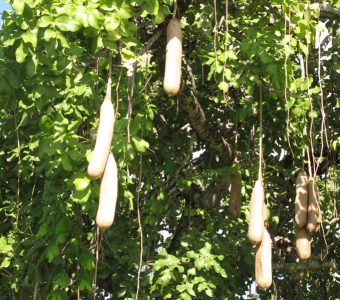


Botanical Name: Kigelia africana (Lam.) Benth.
Synonym: K. pinnata (Jacq) DC.
Common Name: Sausage Tree
Plant Family: Bignoniaceae
Origin: Africa
References: Coates Palgrave p.1013, Storrs p.163, Venter p.198. S.A. No. 678, Zimb. No. 1035
Description: A medium to large tree, semi-deciduous, many branched, with a dense rounded crown and long peduncles hanging from the branches. It occurs at low altitudes in open woodland and riverine fringes. Bark is pale and smooth, leaves are rough. Flowers are in long pendulous sprays of 5 – 12 flowers, a deep velvety red, with a yellow vein on outside. The fruit is also pendulous on a long stalk, up to 1 m long, in the shape of a sausage, grey and rounded at the end, also up to 1 m long and very heavy.
Features of Particular Interest: Flowers and fruit.
Height and Spread: Up to 25m in height and 20m spread.
Periods of Interest:
Leaf: All year round.
Flowering: August to November.
Fruiting: December to June.
Cultivation
Soil and Moisture: Occurs commonly on alluvial soils.
Aspect: Plant in open sun or semi-shade.
Hardiness: Not frost resistant but if protected for the first two years from cold winds they will survive. .
Maintenance and Pruning: Growth rate about 1m a year in warmer areas. It can reach tree proportions in 4 -5 years, although sometimes slower.
Propagation: From seed in September.
Problems and Drawbacks: Tends to loose its leaves and is non-descript when young especially in winter.
Use and Associated Plants: The sausages and flowers are eaten by game and domestic stock, Elephants and bush pigs will often eat the fruit. A dressing for sores and ulcers can be made from the flesh of the fruit, and it is also known for its possible medicine for skin cancer. The sausage tree makes a good shade tree, casting dense shade. It is a good street tree It also makes a good specimen tree in a park in warmer areas. It has a fairly invasive root system. It is a good bonsai specimen. But it is NOT good for car parks or camping under!
Notes: A protected tree in SA. There is a sausage tree at the point where Zimbabwe, Zambia and Namibia’s Caprivi Strip meet at Kazangula. Dr David Livingston pitched camp there just before he saw Victoria Falls for the first time, and he carved his initials in the trunk.
